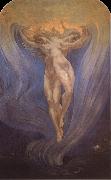|
Here are all the paintings of Jean Delville 01
| ID |
Painting |
Oil Pantings, Sorted from A to Z |
Painting Description |
| 53347 |
 |
Soul Love |
mk229
1900
Egg tempera on canvas
238x150cm
|
| 11706 |
 |
The School of Plato |
1898
6' 9'' x 19' 10 1/4''(206 x 605 cm) |
|
|
| Jean Delville
|
| Belgian Symbolist Painter, 1867-1953
Belgian painter, decorative artist and writer. He studied at the Academie Royale des Beaux-Arts, Brussels, with Jean-Franeois Portaels and the Belgian painter Joseph Stallaert (1825-1903). Among his fellow students were Eugene Laermans, Victor Rousseau and Victor Horta. From 1887 he exhibited at L Essor, where in 1888 Mother (untraced), which depicts a woman writhing in labour, caused a scandal. Although his drawings of the metallurgists working in the Cockerill factories near Charleroi were naturalistic, from 1887 he veered towards Symbolism: the drawing of Tristan and Isolde (1887; Brussels, Musees Royaux B.-A.), in its lyrical fusion of the two bodies, reveals the influence of Richard Wagner. Circle of the Passions (1889), inspired by Dante Alighieri Divina commedia, was burnt c. 1914; only drawings remain (Brussels, Musees Royaux B.-A.). Jef Lambeaux copied it for his relief Human Passions (1890-1900; Brussels, Parc Cinquantenaire). Delville became associated with Josephin Peladan, went to live in Paris and exhibited at the Salons de la Rose+Croix, created there by Peladan (1892-5). A devoted disciple of Peladan, he had his tragedies performed in Brussels and in 1895 painted his portrait (untraced). He exhibited Dead Orpheus (1893; Brussels, Gillion-Crowet priv. col.), an idealized head, floating on his lyre towards reincarnation, and Angel of Splendour (1894; Brussels, Gillion-Crowet priv. col.), a painting of great subtlety.
|
|

